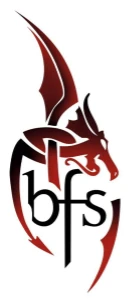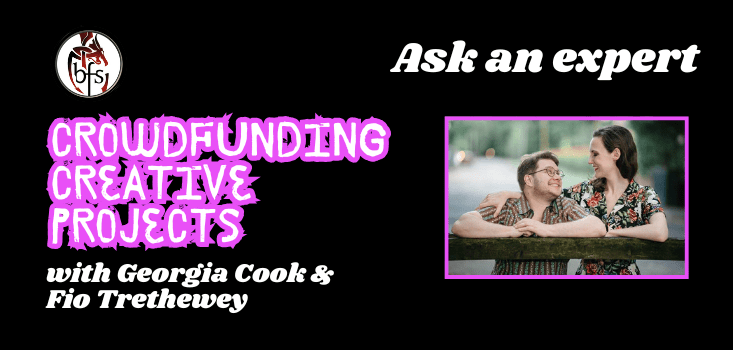In this monthly column, we pose your questions to an expert in a specific field of speculative fiction and the wider ‘industry’. This month, we’ve got Georgia Cook and Fio Trethewey in the hot seat talking about crowdfunding for creative projects. (They also answer some regular ol’ audio drama questions, too!)
This month: Crowdfunding creative projects, with Georgia Cook and Fio Trethewey
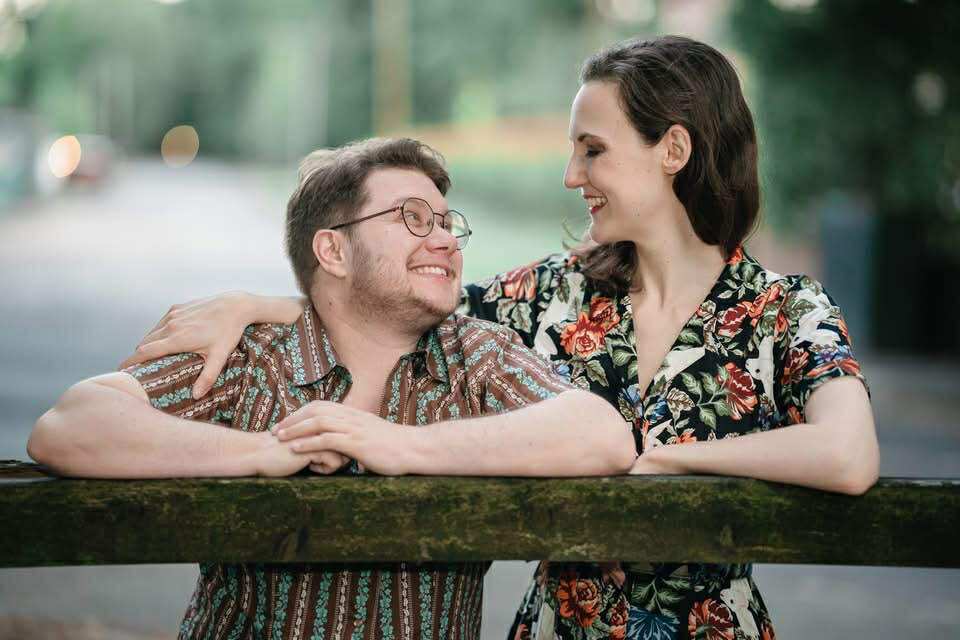
Name: Georgia Cook and Fio Trethewey, creators of The Holmwood Foundation
Website: theholmwoodfoundation.com
Specialism: Georgia and Fio are both writers, but they were speaking here in the guise of audio drama crowdfunding.
Follow: Facebook, Instagram, Twitter, Tumblr
Fio Trethewey and Georgia Cook are a couple with over ten years of combined experience in the professional sphere, writing audio drama for the Doctor Who range with Big Finish, as well as prose for Penguin Books with the BBC, and numerous published short stories in the indie space. They frequently work as a writing team, most recently with the queer Dracula-sequel horror-fiction podcast The Holmwood Foundation, which they write and produce together, and the completed first season of which can be found for free on most podcast platforms.
Crowdfunding: Your Experience
Why did you decide to crowdfund for the Holmwood Foundation? Had you crowdfunded before?
Simply a lack of funds on our end. We were able to pay out of pocket for our pilot episode—keeping it small and contained—but knew we wouldn’t have been able to pay for anything else. We’re just two people, without outside investors or sponsors, so crowdfunding the series was really our only option if we wanted to get it made.
Fio had crowdfunded previously for TTRPGs. Georgia had not.
The first season was very successful—but the follow-up crowdfunding round didn’t meet the target. What did you learn this time around? What happens when something doesn’t hit the target?
We had to make almost double the money needed for season one this time around (£40k, rather than £23k) so that was a huge factor, and one we were very much aware of. Financially, most people are in a much tighter spot this year, and so less willing to pledge to projects. We were also competing with a number of other podcast crowdfunders for backers, so it was a bit of a digital scrum.
For us, we’ll now start looking for alternate funding routes—sponsors, advertisers, podcasting networks. We’re also considering splitting season two in half and crowdfunding each section separately later next year.
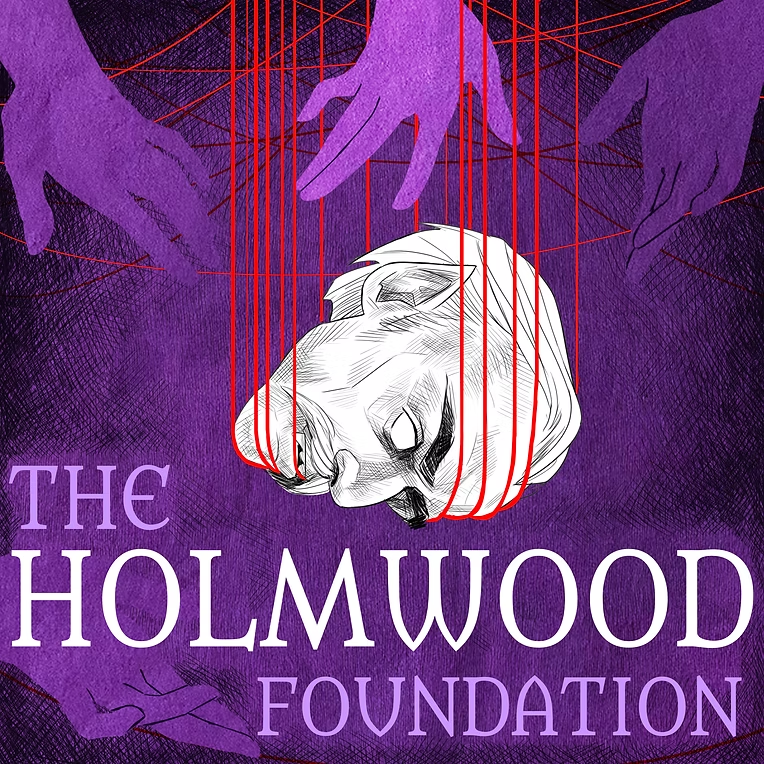
What are the markers that tell you a project will be a good fit for crowdfunding?
Do you need money for it? Can you produce a reliable result at the end to give to your backers? (A book, an audio drama, a TTRPG, a card game, etc.) Is it something you can handle on your own? If you have a product you need funding for that you feel an audience would be willing to crowd source, it’s a good reason to look into it.
What size audience do you need in place before trying crowdfunding?
It really depends on the amount you need to make/what you’re trying to crowdfund for. For Holmwood we created our social media accounts several months in advance, while we were still writing/casting our first season, and had quite good success posting updates and art and interacting with our followers.
Tumblr is GREAT for audio drama. I think Instagram and Tiktok are best for book projects. Facebook and Tiktok might be the best for TTRPGs?
However, our reach isn’t huge. We have just under 5k followers across all of our accounts, not including people who listen to our show without interacting with us—and we had far less than that during our successful £23k Kickstarter, so your own reach doesn’t have to be as huge as you might think.
What do you think of alternative platforms to Kickstarter, such as Backerkit, etc?
We personally chose Kickstarter as it’s an all-or-nothing platform, meaning if you don’t reach the full amount, all the money returns to those who pledged it. We can’t/couldn’t make Holmwood without the full amount, so there would be no point in us only making half the money and then scrambling to work out what to do with it to fill the gaps.
If you are looking for seed money, but are happy to work with whatever money is given to you—for example, printing for a book—you might be able to get away with a project that isn’t all or nothing, so make sure you look at your options carefully.
Incentives and marketing
How do you decide / sort out incentives for backers?
We try to focus heavily on digital/pdf incentives—phone/computer background packs, in-universe handbooks, ad-free episode downloads, annotated script pdfs, etc. Anything that can be sent in an email zip folder rather than by physical mail. Anything physical we try to keep small enough to send in a standard envelope, like postcards, stickers, small badges, etc. This keeps production costs down and helps ensure you’re not suddenly hit by massive unexpected postage costs. Digital rewards can also be sorted prior to or during your campaign, cutting the extra work you need to do post-crowdfunding.
How important are incentives, and having different levels of incentives?
Incentives are very important, in our opinion, especially if you want to appeal to an audience outside of your personal circle (friends, family, etc). People like earning extra things for assisting in a project. Just make sure not to spend too much money/time on those incentives. At the end of the day, your final product is what they’re paying for.
How do you finance the incentives? It’s always struck me as odd that you’re paying out to raise money—you surely have to pay artists first, and for any samples?
We were very fortunate that Georgia is a professional illustrator/cartoonist, meaning we could handle the art side of our incentives in-house.
(Pictured below: some of Georgia’s artwork for Holmwood; this and others are available on all sorts of mediums via her Red Bubble shop!)

If this isn’t feasible for you, we recommend factoring the art cost into the final kickstarter amount (we do this with printing and postage costs regardless), either paying out first with the knowledge you’ll get that money back later, or agreeing a fee split with your artist once the Kickstarter has ended (depending on what your artist is comfortable with). Both have their risks, but crowdfunding always does.
The important thing is to be open and honest with your backers about where the money is going, and why. We recommend including a costs pie chart in your information section. We’ve included our one from our last campaign below.
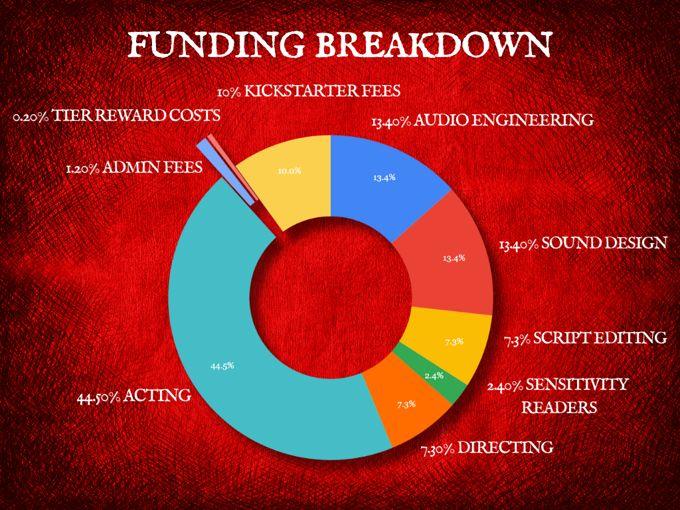
Are there any mitigating strategies for overcoming the issues of tariffs and posting to US backers?
I’m afraid we can’t help with this specific aspect, as we’ve not had to deal with postage under the tariffs. Again, we recommend factoring postage into your final crowdfunding amount, so it doesn’t leave you out of pocket.
Kickstarter has an option to kick the postage costs back to the backers—meaning they pay the extra for it alongside their pledged amount. Just be honest with your backers if you choose this option, so they know in advance.
When you’re crowdfunding to pay for other people to work with you, how do you navigate issues like industry standards, pay that feels fair, audience expectations, and compensating your own time and energy? I know in audio drama at least there is a frankly appalling gap between what listeners/supporters think a show should cost, and what it would actually cost if everyone was paid properly. I realise this might be too big and knotty a question, but I’d also love to hear any thoughts you have on how indie audio drama can grow as a professional industry with regards to that aforesaid appalling gap.
With Holmwood, we wanted to pay all of our cast and crew a comfortable industry rate. This was always our plan, even if it made crowdfunding harder in the long run. As you say, in the AD community there can be an expectation that creatives should always be working for free, or for a much reduced space, purely for the love of the project, otherwise it’s not a “real” indie show. We wanted to combat some of this assumption, especially right now, when creative jobs of all kinds are under threat.
The Audio Drama World
What is the story behind how you got started with Penguin Books and the BBC?
I’m afraid I (Georgia) can’t help too much with this one! After having written scripts for Big Finish Productions on their Doctor Who range for a few years, I was recommended by an in-house writer and contacted by Steve Cole to pitch a story concept for the fifteenth Doctor. The concept was approved, and went down the pipeline to become Ruby Red (pictured). I’m afraid a lot of it was good luck and very nice people vouching for me!
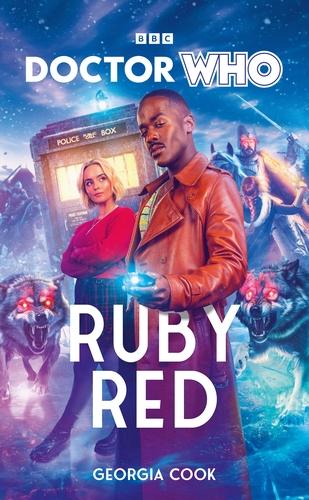
Do you record/produce/edit your own work? If you don’t do audio edits yourself, where would you go to find the best sound editors, if you really need one?
We don’t do any of the above for our Big Finish scripts; that’s all handled in-house. For The Holmwood Foundation, we take on the role of writers and producers. We hire a sound designer/engineer (Benji Clifford) to facilitate recording (usually over Cleanfeed, a brilliant digital recording software, as we don’t have a studio set up and our cast are scattered across the world) and edit the audio.
If you do produce your audio yourself, what is your preference for editing software, and why?
Outside of Holmwood, both of us have some experience editing shorter projects using Audacity and Adobe Audition. This is mostly due to Audacity being free, and for Fio as he gets AA with work. To my knowledge, Reaper is one of the most popular pieces of software in the indie space. Basically, use what you’re comfortable with—you’re going to be staring at wavelines a lot—and what you can afford.
What is the biggest bottleneck for producing an audio drama for you as collaborative writers? Do you have a process?
We work with a very tight outline for each season, so we know exactly what happens in each episode, and sometimes in every individual scene. From there, we each tackle the bits of that particular script we are most excited about, and then slowly stitch them together. It’s worked very well for us so far! We also have a fantastic editor (Kat Armitage), who keeps us on our toes and points out any weak points!
Writing for us isn’t the biggest issue; we love writing together. It’s more the production timeline—making sure people are available to perform together, as a lot of our recording is done synchronously (all our actors together, online). This means juggling timezones and availability, but it’s very much worth it!
Have you used guest stars in cameos or even main roles? If so, have you seen a marked improvement in downloads for those episodes? For example, Dark Dice (creators of white vaults) brought in Jeff Goldblum for a season.
Not intentionally! As we were new to the indie audio drama community when we first started out, we went to meet ups and conventions and met some very lovely voice actors, who we then approached for small roles in Holmwood. We didn’t realise at the time that a number of them already played fan favourite characters across multiple audio drama shows. Having them plus our incredible leads Rebecca Root and Sean Carlsen meant that people tended to find our podcast when looking for more work done by their favourite actors, then (hopefully) stuck around for the rest of the story.
We’ve never had stunt casting to the extent of Jeff Goldblum, so I can’t vouch for the uptick in view, but having actors people recognise on a cast list can help bring in interested listeners!
What is the most effective/viral marketing you have ever done for your shows?
Talking about the show on Tiktok was helpful, especially our videos sharing upcoming guests. For Season One’s Kickstarter we shared a video of us cooking Paprika Hendl, which is the recipe that Jonathan Harker finds for Mina in the first chapter of Dracula, which did quite well.
We also create a lot of original art of our characters, including little meme responses to audience questions, which helps people get involved with talking to us, and do well.
We created a deliberately comical powerpoint about the show, called ‘Why You Should Listen To The Holmwood Foundation’, which did very good numbers on Tumblr.
Tumblr and Tiktok are great for audio drama.
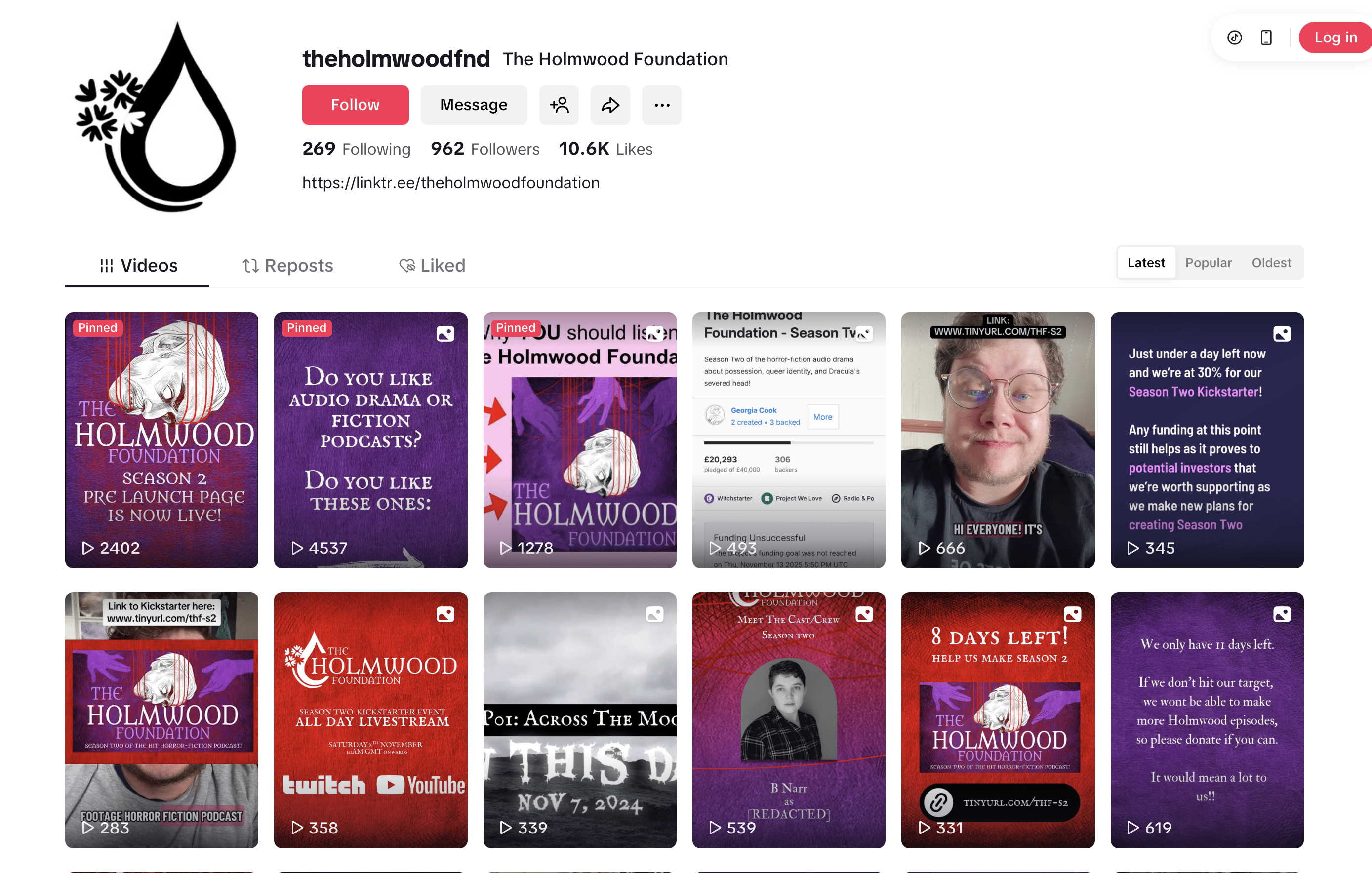
Ads are a plague on audio dramas. How do you feel about them, and do you have thoughts on strategies to reduce ads using paid ad-free alternatives, such as Patreon support?
With this question we have to respectfully disagree.
Ads may be annoying, but they are currently one of the only reliable way audio creators, especially indie creators, can get paid for their work, and what we get paid for those ads is a tiny amount per listen—we make about £20 per month across our entire show, and that’s locked behind a pay-block on Acast until we make a certain amount.
It’s the trade-off to not have our shows put behind a pay wall. You may have to listen to ads, but you don’t have to pay to listen to our shows. You still get them for free.
Many audio drama creators do put ad-free versions of their shows behind Patreon and/or, as we did, have this as an incentive on Kickstarter, but plenty of casual listeners won’t go that far for shows they like, or be able to drop Patreon money every month.
Read previous columns
Ask an expert
- October 2025: Creating darkness, with Daniel Willcocks
- September 2025: Working with book bloggers, with Kayleigh Dobbs of Happy Goat Horror
- August 2025: Websites for creatives, with E.M. Faulds
- July 2025: Anthologies, with Dan Coxon
- June 2025: Self-publishing, with AK Faulkner
- May 2025: Indie presses, with Black Shuck Books’ Steve J Shaw
- April 2025: Being a traditionally-published author with Adrian Tchaikovsky
- March 2025: SFFH artwork with Jenni Coutts
Ask an agent, with Laura Bennett:
